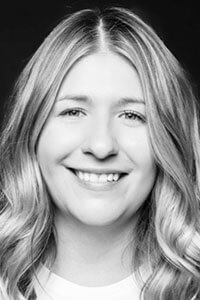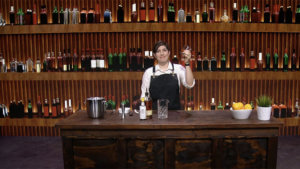
Uber Freight CEO Lior Ron stands in front of Chicago’s Old Post Office, or does he? Planners of the 2020 Deliver conference used 3D scan technology to capture images of the building for a background placed behind him as he filmed on an XR — extended reality — stage (right).
When Uber Freight, a shipping division of the San Francisco–based ride-sharing company, ended its 2019 Deliver conference with the message “See you in Chicago!” it carried more weight than a simple announcement of the next year’s meeting location. It marked an organizational milestone — Uber Freight’s offices were scheduled in 2020 to move to Chicago’s Old Post Office, a 1923 Art Deco landmark in downtown, which was also to be the location for Deliver 2020.

Cassandra Costello
The pandemic didn’t stop Uber Freight’s office move-in, but the plan to hold the conference at the Old Post Office in September was scrapped — which was a big disappointment to Cassandra Costello, the founder and CEO of MoonLab Productions, a Santa Monica, California–based event-production company. MoonLab was planning the conference for Uber Freight for the third year, and Costello and her team had been “super stoked” about staging the meeting in such a beautiful, historic building, she said, as well as for what the venue signified for Uber Freight — expanding brand awareness as well as its physical footprint in Chicago. In making the switch to digital, their focus became: “How can we elevate this? How can we anchor it in the location and still broadcast it?” she said. “We didn’t want to have a standard virtual conference where people were stuck behind the screen,” looking at other heads in boxes.
The solution? If the meeting couldn’t actually be at the Old Post Office, it could still appear to take place there. Costello flew to Chicago with a team who used 3D scan technology to capture images of the Old Post Office’s exterior and interior, which they used to build a digital model of the building from the ground up. MoonLab then commissioned an XR stage — XR stands for “extended reality” — to be built at a production facility in Berkeley, across the San Francisco Bay from Uber’s headquarters, where graphics and video could be displayed onto LED screens or directly into the broadcast feed and layered both in front of and behind live presenters, creating an immersive, 3D effect.
“We did a warehouse scene,” Costello said. “We did the Old Post Office scenes. And we did some static, graphic looks that were just for event branding — beautiful patterns.”
Most of the main presentations were filmed in front of a series of LED walls, and international speakers and others who couldn’t travel to the Bay Area were recorded remotely, she said. MoonLab also went on location to produce videos featuring Uber Freight’s nonprofit partners and customers. The shoots were geographically diverse, including one in southern California featuring The Farmlink Project, which delivers surplus food from farms to those who need it, and an Uber Freight customer in New Jersey who had converted a manufacturing plant to make PPE equipment.

A San Francisco mixologist, filming in front of a digital bar background, teaches attendees how to make Old-Fashioneds using kits that were mailed to them in advance.
Costello and her team also gave a lot of thought to how to open and close the event in a way that could give participants the sense that they were arriving and departing in a real city for the meeting, she said. They relied on drone footage taken over Chicago, which was used with an animation that transported Uber Freight CEO Lior Ron to the front steps of the Old Post Office, she said. “And then, for the closing segment on day two, we flew out of there.”
A digital bar background created for a happy hour networking event also was tethered to a real location. Uber’s headquarters sits next to the Chase Center in San Francisco, and MoonLab hired a mixologist from the venue who taught attendees how to make Old-Fashioneds using kits that were mailed to them in advance. The kits came in a box that also held branded notebooks and pens, snacks, and cold brew kits; Uber Eats “got involved and sent everybody gift cards so they could order lunch and dinner in,” Costello said.
“There were a lot of moving parts” for the meeting, but it’s important to push the boundaries of what’s possible, especially when designing virtual events, she said. “We don’t need to be tied to basic platform experiences,” she added. Moon-Lab Productions has become very diversified in the services they offer, Costello said. In addition to live events and virtual events, they do environmental, packaging, digital motion, and graphic design. “We follow the trends in different industries,” she said. “It really helps us think outside the box. [Event designers] were put on this Earth for a reason — to keep people excited and to create experiences for people who don’t really think that way.”
Barbara Palmer is deputy editor at Convene.
